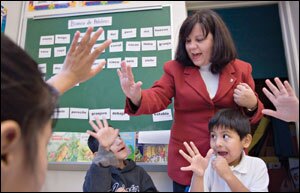On a December morning at Lincoln Avenue School in Orange, New Jersey, a gritty suburb of Newark, Latino 1st graders who don’t know much English read a story about a rat in English, and then follow it with a story about a rat in Spanish.
During the 120-minute literacy block, the students’ teacher, Maria Albuquerque-Malaman, and ESL instructor Enid Shapiro-Unger use the theme of animals and their homes to teach in both English and Spanish.
Such scenes are not unusual in the state, which requires bilingual education in districts with at least 20 students who speak the same native language.

“The transition from the native language to the second language goes more smoothly,” Albuquerque-Malaman says.
New Jersey’s embrace of bilingual education, in which students are taught some subjects in their native tongue while learning English, runs counter to prevailing national trends: Many school districts in Arizona, California, and Massachusetts abandoned the approach after voters approved state ballot measures to curtail it.
But Garden State officials, who have also mandated instruction in Spanish for the federal Reading First program and other early reading initiatives, say research is on their side.
Fred Carrigg, the special assistant for literacy to New Jersey’s education commissioner, cites two reviews of research to back the state’s requirements: Preventing Reading Difficulties in Young Children, published by the National Research Council in 1998, and Developing Literacy in Second-Language Learners: Report of the National Literacy Panel on Language-Minority Children and Youth, published last year.
The federal Department of Education paid $1.8 million for the National Literacy Panel’s study—which concludes there is a “small to moderate” advantage for bilingual education over English-only methods—but then declined to publish it. Department officials said the work didn’t stand up to the peer-review process, though critics who praised the research have suggested the decision was politically motivated.
When asked why he puts stock in the findings, Carrigg says the federal government’s criticism of the study concerned procedures and process, not “recommendations or results.” He adds: “We note that fine line.”
But officials elsewhere have disregarded the literacy panel’s finding. Margaret Garcia Dugan, who oversees programs for English-language learners for the Arizona Department of Education and opposes bilingual education, says the federal department’s decision not to publish the study raised “a red flag” for her, pointing to potential questions about its validity.
Not even all New Jersey teachers agree with their state’s administrators. “I feel that bilingual methods hold the students back,” wrote Charmaine Della Bella, the ESL teacher for the K-8 Norwood Public School, in an e-mail. She said ESL techniques have worked for the 19 English learners in her school, all of whom are Korean.
Carrigg insists that the state’s policies are working: Half of New Jersey’s 3rd grade English learners are scoring at or above the “proficient” level on the state’s language arts test, which must be taken in English.
Russell Rumberger, the director of the Linguistic Minority Research Institute at the University of California at Santa Barbara, applauds New Jersey officials for taking what he views as an evidence-based approach. “The research is increasingly supporting the idea that bilingual education is not only not bad, but is beneficial,” he says.




